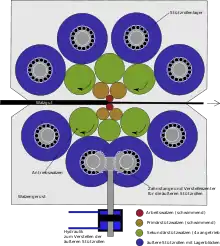Z-mill
A Z-Mill or Sendzimir Mill is a machine for rolling steel.[1][2] Unlike a traditional rolling mill this 20-high cluster mill configuration utilizes cascaded supporting rolls to apply force on the small work rolls in the center. This allows the application of a higher roll pressure without bending the work rolls, which would result in poor metal quality. Thus very hard and elastic materials can be rolled.

Development
The evolution to the current 20-High Cluster Sendzimir Mill from the early 12-High configuration[1] was pioneered by Tadeusz Sendzimir in the early 1930s. The designs for the Sendzimir Mill were patented[3][4] by T. Sendzimir, Inc. Significant design improvements were made by T. Sendzimir, Inc. including the flexible shaft backing assemblies and segmented idler rolls, as well as tapered edge intermediate rolls with lateral adjust for superior shape control. With advent of Finite Element Analysis technology T. Sendzimir, Inc. iterated the mono-block housing design to create the Zero Crown Housing solution. This reduced the amount of material required for the housing, while creating uniform elastic deformation across the housing during rolling in order to maintain a better shape profile of the strip.
Applications
- Autobody sheet
- Deep and extra-deep drawing, low-carbon steels
- Feed stock for the manufacture of tinplate
- Austenitic, martensitic, and ferritic stainless steels
- Non-oriented as well as grain-oriented silicon steels
- High-carbon steels for items such as razor blades and saws
- Nonferrous metals such as brass and special alloys of brass, copper, bronze, berylium copper, and bimetals
- Metals such as aluminum, zirconium, molybdenum, silver, gold, tantalum, titanium, cobalt, and nickel, and their alloys, such as aluchrom
Advantages
20-High mills are unique in that they have a small, chockless work roll and a cluster roll configuration supported by the Backing Assemblies. The cluster configuration transmits the roll separating force from the work rolls to the mill housing. The small size of the work roll permits superior reductions on very hard materials, such as stainless steel or titanium. Furthermore, the small, chock-less work roll allows for a quick roll change enabling less down time, and more efficient variable production runs.
Sendzimir mills can be used to roll extremely hard materials to very thin gauges with few, if any, intermediate anneals. The bearing-saddle-bearing configuration of the back-up rolls transmits the roll separating force along the length of the work rolls, through the intermediate rolls, to the back-up assemblies, and finally to the rigid mono-block housing. Since the work rolls are supported throughout their length, any mechanical deflection is minimal, and extremely close gauge tolerances can be maintained across the full width of the material being rolled.
Nomenclature
Sendzimir Mills commonly carry the prefix ZR, which stands for "Zimna," the Polish word for "cold," and "reversing." This prefix was used the first time to describe Silesia's first reduction mill. The numbers, and sometimes letters, following this prefix describe the mill's geometry, the relative size of its work roll, and the widest strip that the mill can roll.
The number immediately following the "ZR" indicates the mill "section" size comprising a combination of the backing bearings, the work rolls, and so on. For example, a ZR 23 has backing bearings with a diameter of 8.858 inches (225 mm) and work rolls with a diameter of 1.578 inches (40 mm). A ZR 32, on the other hand, has backing bearings of 1.875 inches (48mm) in diameter and work rolls of 0.250 inches (6.5mm) in diameter. The significance of the difference is that a ZR 23 can roll ferrous and nonferrous materials down to a minimum gauge of 0.002 inches (50 microns), while a ZR 32 can roll ultra-thin nonferrous foil down to 0.0001 inches (2.5 microns), which is 20 times thinner.
Design Features
- Hydraulic lateral adjust
- As-U-Roll Crown Control & Flexible Backing Assemblies
- Zero Crown Housing
References
- Bhaduri, Amit (2018). Mechanical Properties and Working of Metals and Alloys. Springer. pp. 527 ff. ISBN 9789811072093.
- Winters, Gary L.; Nutt, Michael J. (2003). Stainless Steels for Medical and Surgical Applications. ASTM International. pp. 62–70. ISBN 9780803134591.
- US patent 2169711, Tadeusz Sendzimir, "Rolling Mill Adjustment", published 1939-08-15
- US patent 2479974, Tadeusz Sendzimir, John E. Eckert, "Design and construction of rolling mills", published 1949-08-23